fuel cap LEXUS RX350 2011 Owners Manual
[x] Cancel search | Manufacturer: LEXUS, Model Year: 2011, Model line: RX350, Model: LEXUS RX350 2011Pages: 821, PDF Size: 13.27 MB
Page 1 of 821
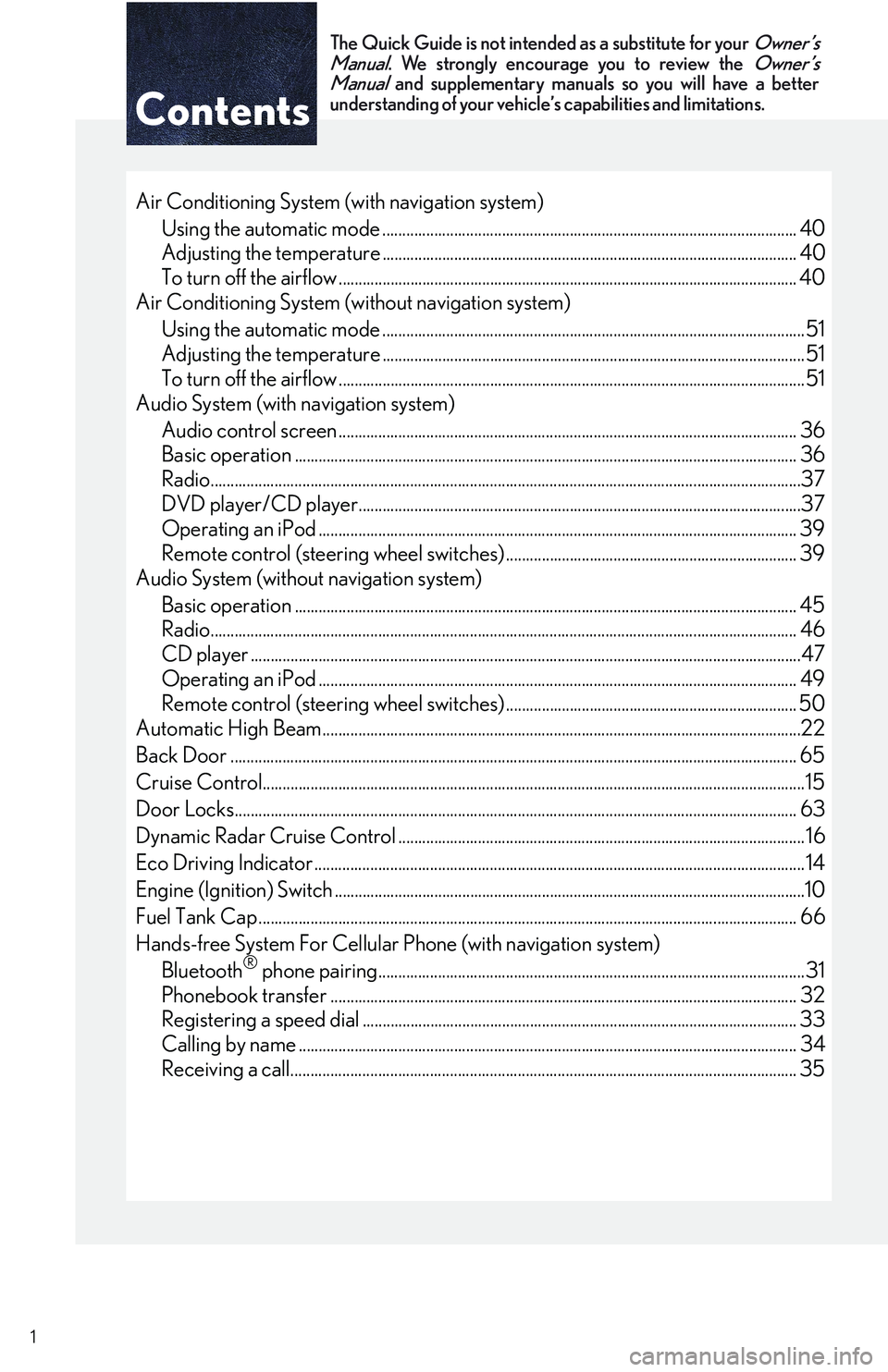
Contents
The Quick Guide is not intended as a substitute for your
Owner’s
Manual
. We strongly encourage you to review the
Owner’s
Manual
and supplementary manuals so you will have a betterunderstanding of your vehicle’s capabilities and limitations.
1
Air Conditioning System (with navigation system)
Using the automatic mode ........................................................................................................40
Adjusting the temperature ........................................................................................................ 40
To turn off the airflow ................................................................................................................... 40
Air Conditioning System (without navigation system)
Using the automatic mode ..........................................................................................................51
Adjusting the temperature ..........................................................................................................51
To turn off the airflow .....................................................................................................................51
Audio System (with navigation system)
Audio control screen ................................................................................................................... 36
Basic operation .............................................................................................................................. 36
Radio....................................................................................................................................................37
DVD player/CD player...............................................................................................................37
Operating an iPod ........................................................................................................................ 39
Remote control (steering wheel switches) ......................................................................... 39
Audio System (without navigation system)
Basic operation .............................................................................................................................. 45
Radio................................................................................................................................................... 46
CD player ..........................................................................................................................................47
Operating an iPod ........................................................................................................................ 49
Remote control (steering wheel switches) ......................................................................... 50
Automatic High Beam........................................................................................................................22
Back Door .............................................................................................................................................. 65
Cruise Control........................................................................................................................................15
Door Locks............................................................................................................................................. 63
Dynamic Radar Cruise Control ...................................................................................................... 16
Eco Driving Indicator ........................................................................................................................... 14
Engine (Ignition) Switch ......................................................................................................................10
Fuel Tank Cap ....................................................................................................................................... 66
Hands-free System For Cellular Phone (with navigation system)
Bluetooth® phone pairing...........................................................................................................31
Phonebook transfer ..................................................................................................................... 32
Registering a speed dial ............................................................................................................. 33
Calling by name ............................................................................................................................. 34
Receiving a call............................................................................................................................... 35
Page 66 of 821
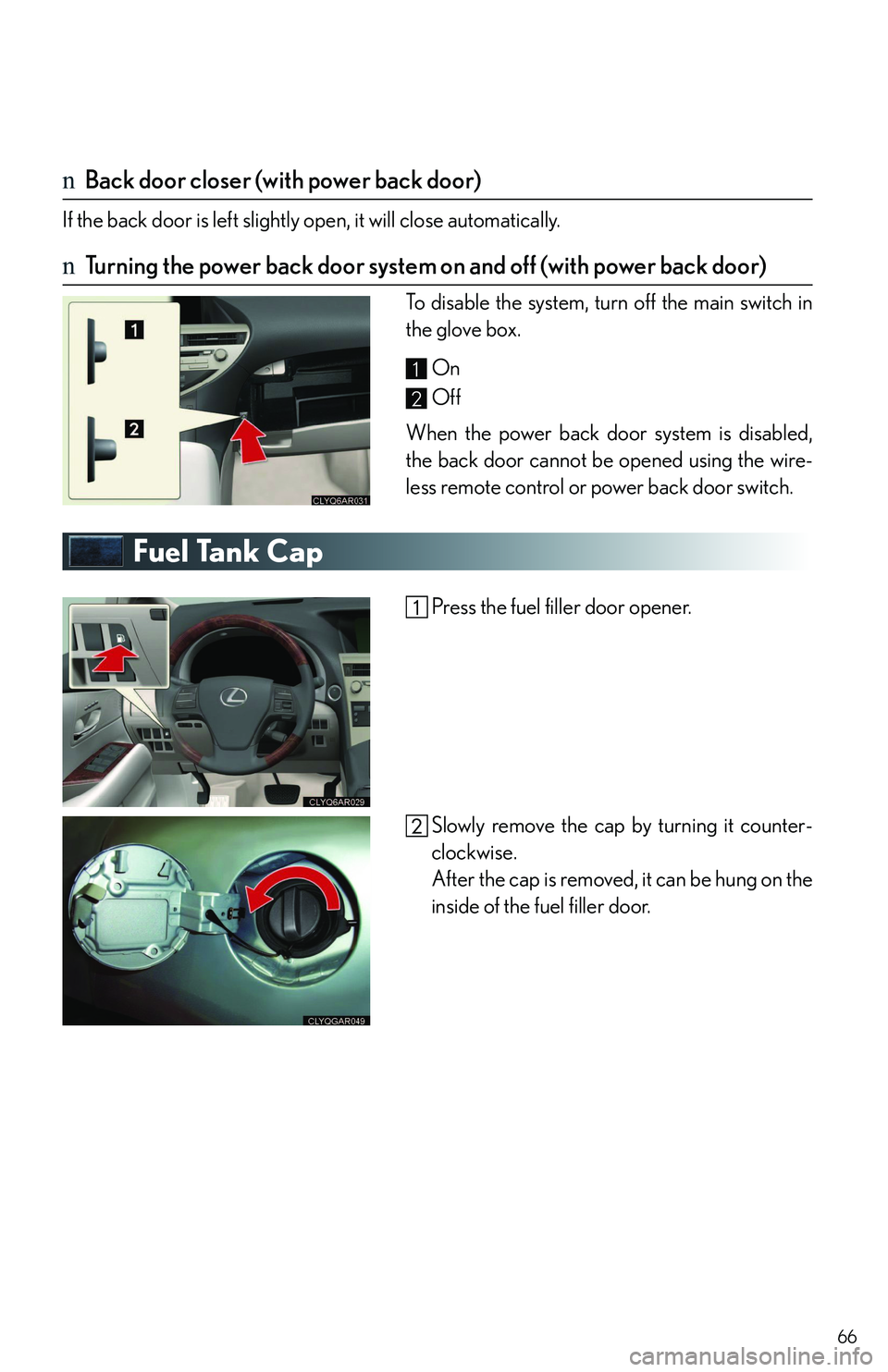
66
nBack door closer (with power back door)
If the back door is left slightly open, it will close automatically.
nTurning the power back door system on and off (with power back door)
To disable the system, turn off the main switch in
the glove box.
On
Off
When the power back door system is disabled,
the back door cannot be opened using the wire-
less remote control or power back door switch.
Fuel Tank Cap
Press the fuel filler door opener.
Slowly remove the cap by turning it counter-
clockwise.
After the cap is removed, it can be hung on the
inside of the fuel filler door.
1
2
Page 76 of 821
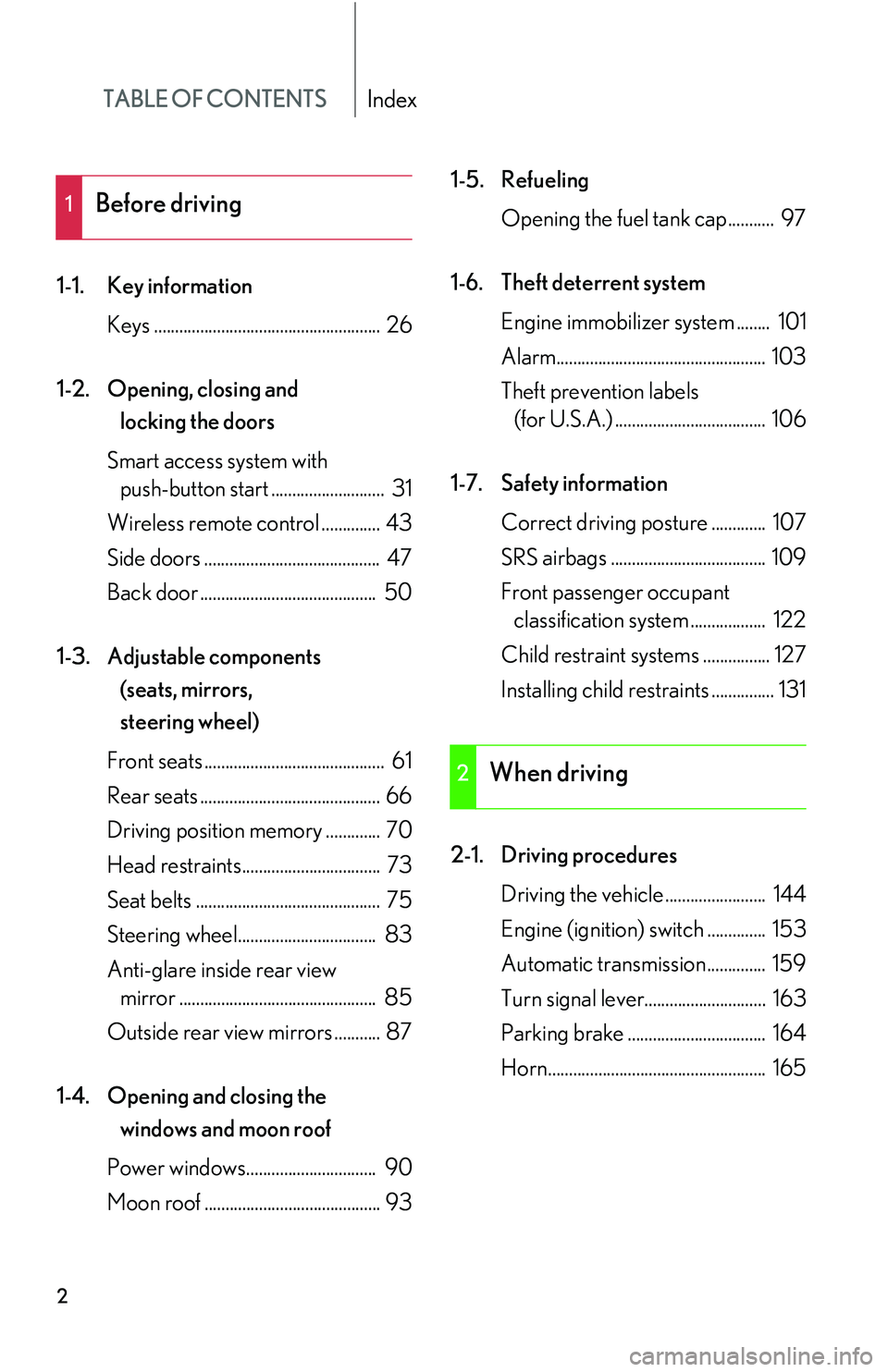
TABLE OF CONTENTSIndex
2
1-1.Key information
Keys ...................................................... 26
1-2. Opening, closing and
locking the doors
Smart access system with
push-button start ........................... 31
Wireless remote control .............. 43
Side doors .......................................... 47
Back door .......................................... 50
1-3. Adjustable components
(seats, mirrors,
steering wheel)
Front seats ........................................... 61
Rear seats ........................................... 66
Driving position memory ............. 70
Head restraints................................. 73
Seat belts ............................................ 75
Steering wheel................................. 83
Anti-glare inside rear view
mirror ............................................... 85
Outside rear view mirrors ........... 87
1-4. Opening and closing the
windows and moon roof
Power windows............................... 90
Moon roof .......................................... 93
1-5. Refueling
Opening the fuel tank cap........... 97
1-6. Theft deterrent system
Engine immobilizer system ........ 101
Alarm.................................................. 103
Theft prevention labels
(for U.S.A.) .................................... 106
1-7. Safety information
Correct driving posture ............. 107
SRS airbags ..................................... 109
Front passenger occupant
classification system .................. 122
Child restraint systems ................ 127
Installing child restraints ............... 131
2-1. Driving procedures
Driving the vehicle ........................ 144
Engine (ignition) switch .............. 153
Automatic transmission.............. 159
Turn signal lever............................. 163
Parking brake ................................. 164
Horn.................................................... 165
1Before driving
2When driving
Page 170 of 821
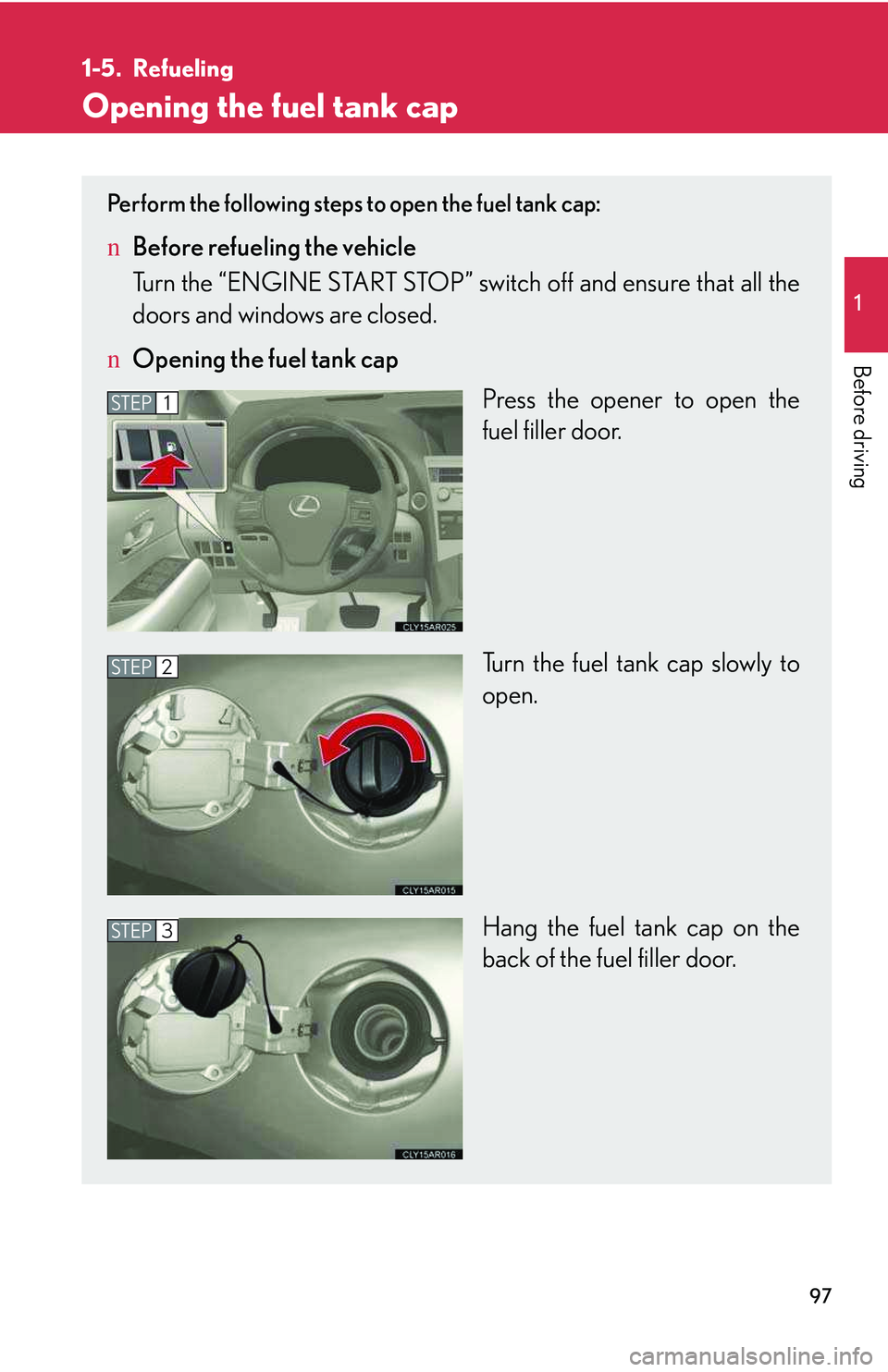
97
1
Before driving
1-5. Refueling
Opening the fuel tank cap
Perform the following steps to open the fuel tank cap:
nBefore refueling the vehicle
Turn the “ENGINE START STOP” switch off and ensure that all the
doors and windows are closed.
nOpening the fuel tank cap
Press the opener to open the
fuel filler door.
Turn the fuel tank cap slowly to
open.
Hang the fuel tank cap on the
back of the fuel filler door.
STEP1
STEP2
STEP3
Page 171 of 821
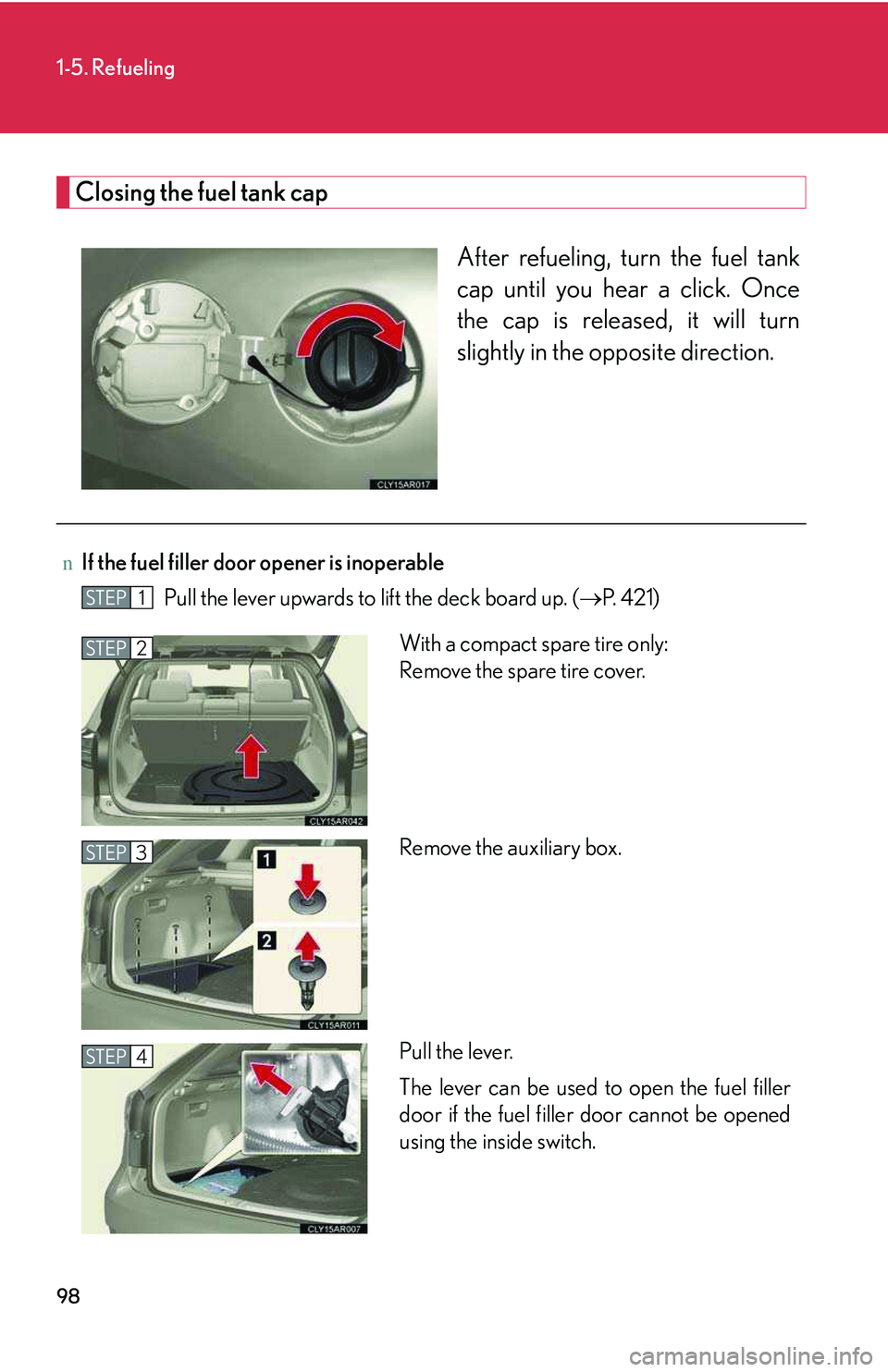
98
1-5. Refueling
Closing the fuel tank cap
After refueling, turn the fuel tank
cap until you hear a click. Once
the cap is released, it will turn
slightly in the opposite direction.
nIf the fuel filler door opener is inoperable
Pull the lever upwards to lift the deck board up. (�→P. 4 2 1 )STEP1
With a compact spare tire only:
Remove the spare tire cover.
Remove the auxiliary box.
Pull the lever.
The lever can be used to open the fuel filler
door if the fuel filler door cannot be opened
using the inside switch.
STEP2
STEP3
STEP4
Page 172 of 821

99
1-5. Refueling
1
Before driving
CAUTION
nWhen refueling the vehicle
Observe the following precautions while refueling the vehicle. Failure to do so may
result in death or serious injury.
lAfter exiting the vehicle and before opening the fuel door, touch an unpainted
metal surface to discharge any static electricity. It is important to discharge static
electricity before refueling because sparks resulting from static electricity can
cause fuel vapors to ignite while refueling.
lAlways hold the grips on the fuel tank cap and turn it slowly to remove it.
A whooshing sound may be heard when the fuel tank cap is loosened. Wait until
the sound cannot be heard before fully removing the cap. In hot weather, pressur-
ized fuel may spray out of the filler neck and cause injury.
Install the clips.STEP5
Page 173 of 821

100
1-5. Refueling
CAUTION
lDo not allow anyone that has not discharged static electricity from their body to
come close to an open fuel tank.
lDo not inhale vaporized fuel.
Fuel contains substances that are harmful if inhaled.
lDo not smoke while refueling the vehicle.
Doing so may cause the fuel to ignite and cause a fire.
lDo not return to the vehicle or touch any person or object that is statically
charged.
This may cause static electricity to build up, resulting in a possible ignition hazard.
nWhen refueling
Securely insert the fuel nozzle into the fuel filler neck. If fuel is added with the nozzle
slightly lifted away from the fuel filler neck, the automatic shut off function may not
operate, resulting in fuel overflowing from the tank.
nWhen replacing the fuel cap
Do not use anything but a genuine Lexus fuel tank cap designed for your vehicle.
Doing so may cause a fire or other incident which may result in death or serious
injury.
NOTICE
nRefueling
Do not spill fuel during refueling.
Doing so may damage the vehicle, such as causing the emission control system to
operate abnormally or damaging fuel system components or the vehicle's painted
surface.
Page 321 of 821
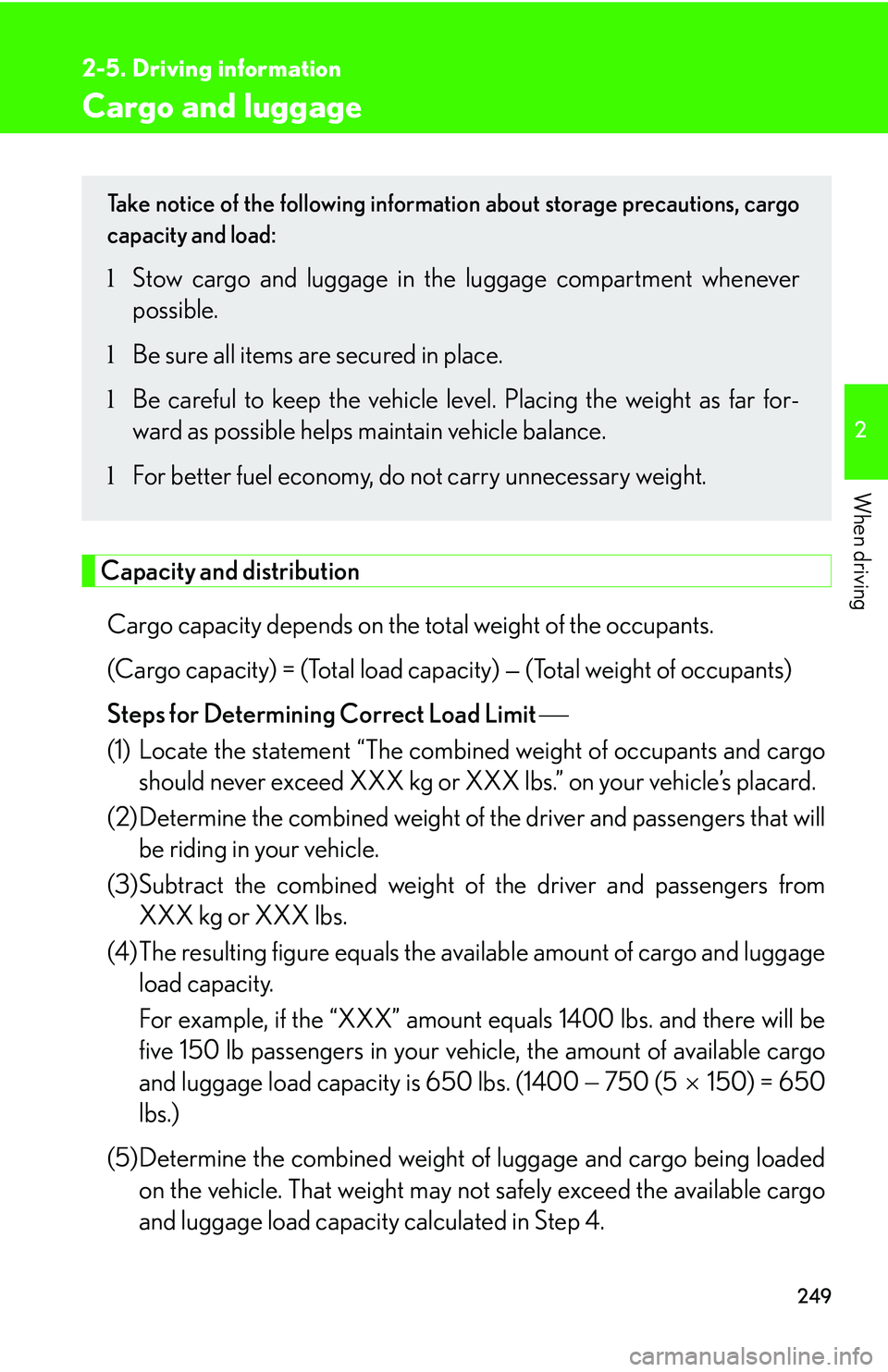
249
2-5. Driving information
2
When driving
Cargo and luggage
Capacity and distribution
Cargo capacity depends on the total weight of the occupants.
(Cargo capacity) = (Total load capacity) — (Total weight of occupants)
Steps for Determining Correct Load Limit �⎯
(1) Locate the statement “The combined weight of occupants and cargo
should never exceed XXX kg or XXX lbs.” on your vehicle’s placard.
(2) Determine the combined weight of the driver and passengers that will
be riding in your vehicle.
(3)Subtract the combined weight of the driver and passengers from
XXX kg or XXX lbs.
(4)The resulting figure equals the available amount of cargo and luggage
load capacity.
For example, if the “XXX” amount equals 1400 lbs. and there will be
five 150 lb passengers in your vehicle, the amount of available cargo
and luggage load capacity is 650 lbs. (1400 �− 750 (5� �×� 150) = 650
lbs.)
(5)Determine the combined weight of luggage and cargo being loaded
on the vehicle. That weight may not safely exceed the available cargo
and luggage load capacity calculated in Step 4.
Take notice of the following information about storage precautions, cargo
capacity and load:
lStow cargo and luggage in the luggage compartment whenever
possible.
lBe sure all items are secured in place.
lBe careful to keep the vehicle level. Placing the weight as far for-
ward as possible helps maintain vehicle balance.
lFor better fuel economy, do not carry unnecessary weight.
Page 526 of 821
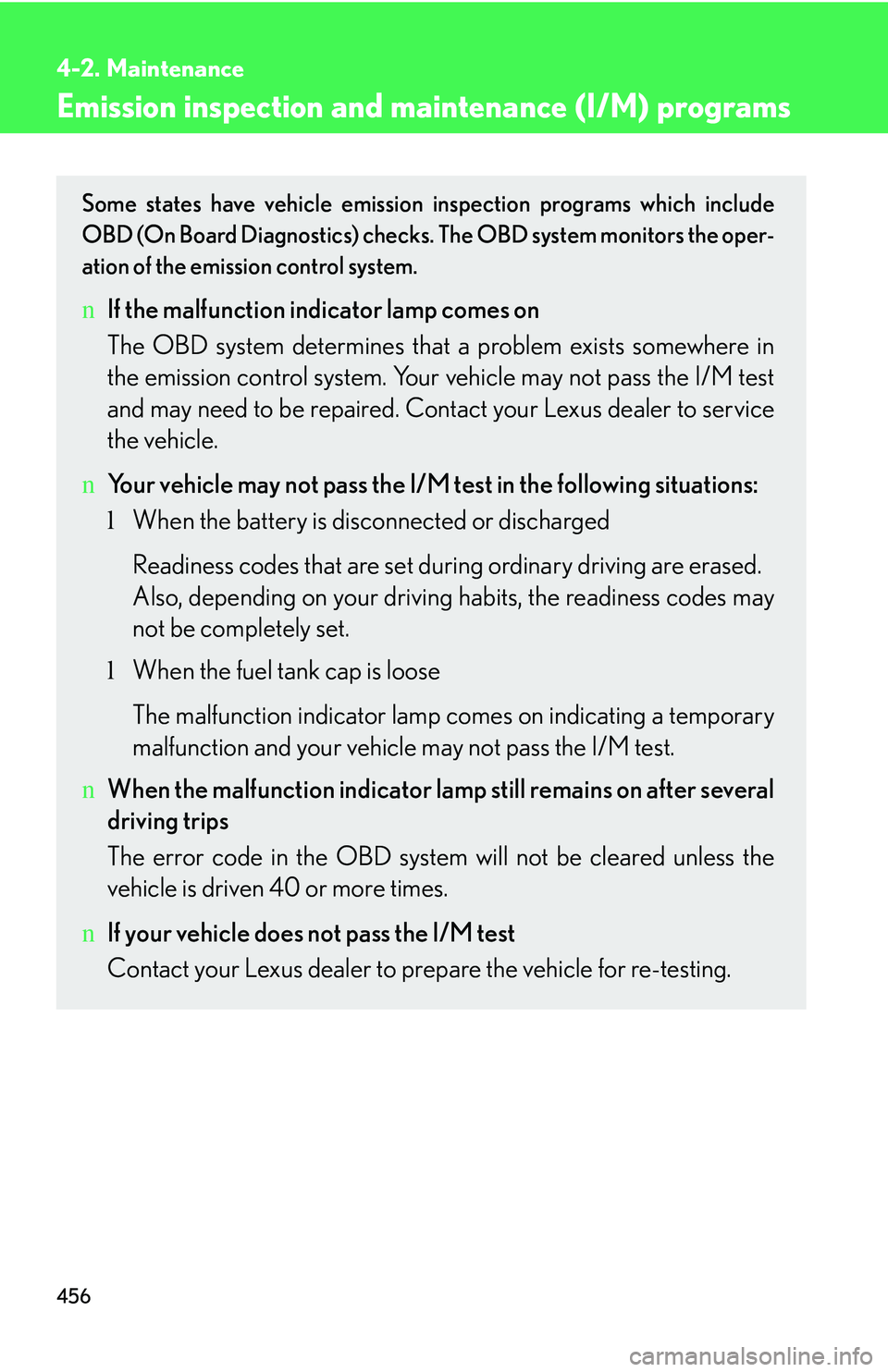
456
4-2. Maintenance
Emission inspection and maintenance (I/M) programs
Some states have vehicle emission inspection programs which include
OBD (On Board Diagnostics) checks. The OBD system monitors the oper-
ation of the emission control system.
nIf the malfunction indicator lamp comes on
The OBD system determines that a problem exists somewhere in
the emission control system. Your vehicle may not pass the I/M test
and may need to be repaired. Contact your Lexus dealer to service
the vehicle.
nYour vehicle may not pass the I/M test in the following situations:
lWhen the battery is disconnected or discharged
Readiness codes that are set during ordinary driving are erased.
Also, depending on your driving habits, the readiness codes may
not be completely set.
lWhen the fuel tank cap is loose
The malfunction indicator lamp comes on indicating a temporary
malfunction and your vehicle may not pass the I/M test.
nWhen the malfunction indicator lamp still remains on after several
driving trips
The error code in the OBD system will not be cleared unless the
vehicle is driven 40 or more times.
nIf your vehicle does not pass the I/M test
Contact your Lexus dealer to prepare the vehicle for re-testing.
Page 559 of 821
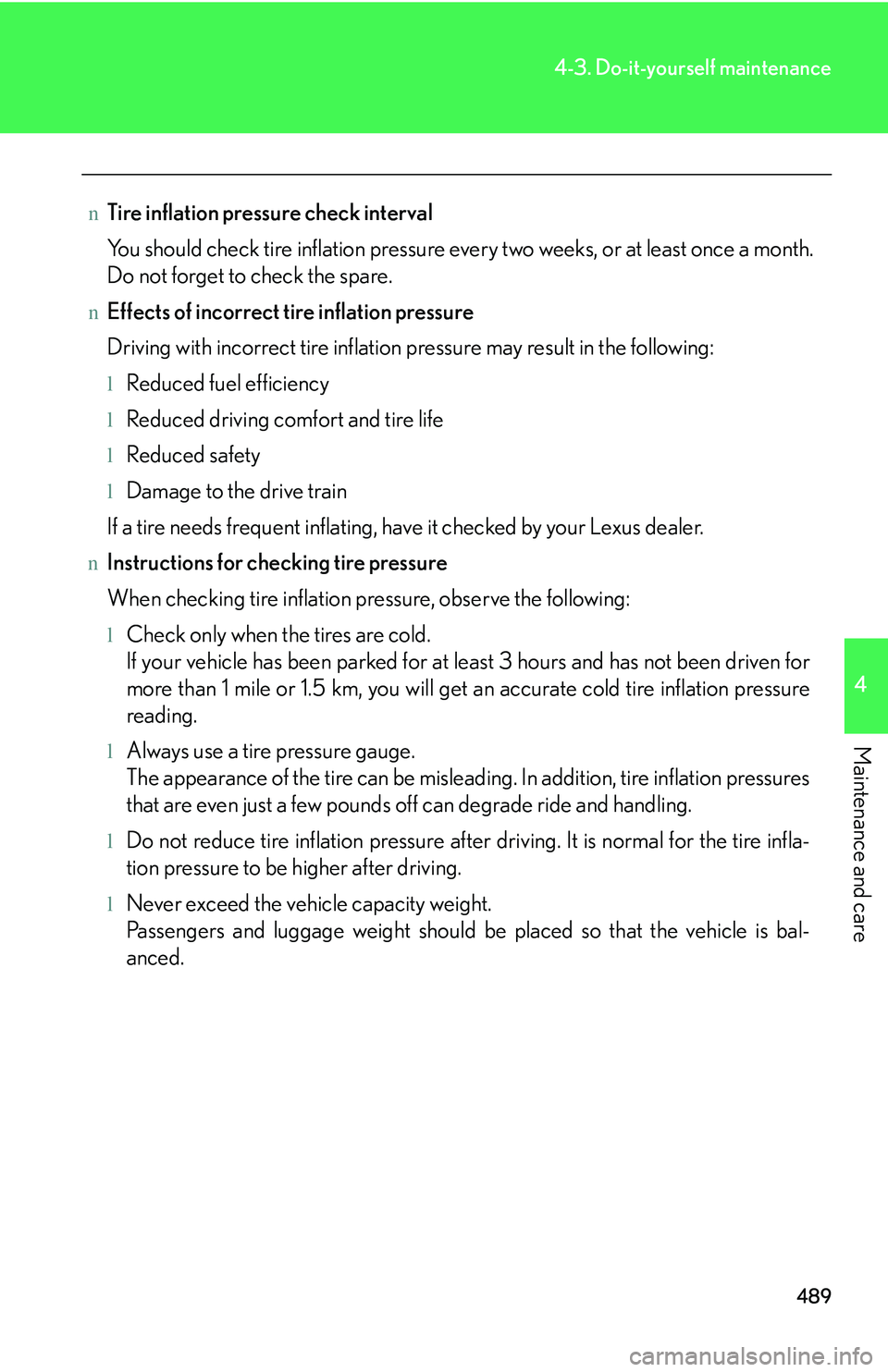
489
4-3. Do-it-yourself maintenance
4
Maintenance and care
nTire inflation pressure check interval
You should check tire inflation pressure every two weeks, or at least once a month.
Do not forget to check the spare.
nEffects of incorrect tire inflation pressure
Driving with incorrect tire inflation pressure may result in the following:
lReduced fuel efficiency
lReduced driving comfort and tire life
lReduced safety
lDamage to the drive train
If a tire needs frequent inflating, have it checked by your Lexus dealer.
nInstructions for checking tire pressure
When checking tire inflation pressure, observe the following:
lCheck only when the tires are cold.
If your vehicle has been parked for at least 3 hours and has not been driven for
more than 1 mile or 1.5 km, you will get an accurate cold tire inflation pressure
reading.
lAlways use a tire pressure gauge.
The appearance of the tire can be misleading. In addition, tire inflation pressures
that are even just a few pounds off can degrade ride and handling.
lDo not reduce tire inflation pressure after driving. It is normal for the tire infla-
tion pressure to be higher after driving.
lNever exceed the vehicle capacity weight.
Passengers and luggage weight should be placed so that the vehicle is bal-
anced.